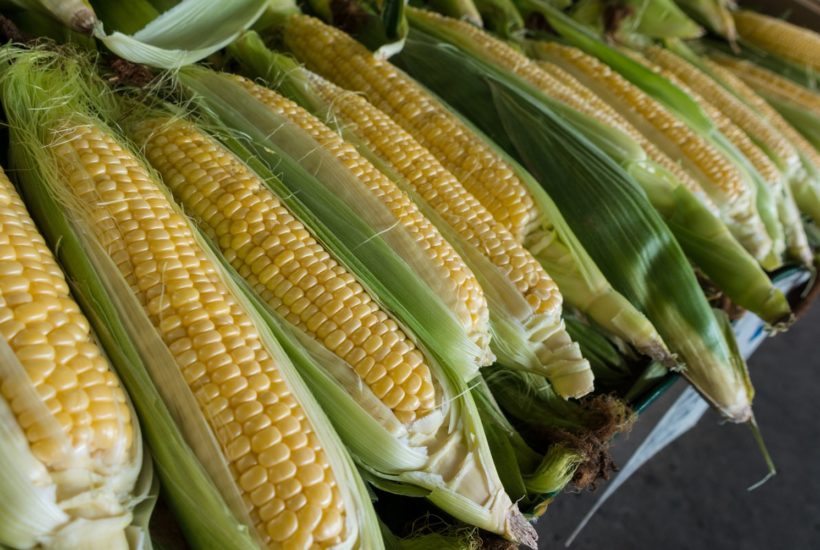Featured
Big production estimates, bad local demand ideas push corn lower
FC Stone and Informa said the potential for corn production to be as big as USDA estimated last month. Traders are said to think that there will be more than enough corn for any demand. Demand ideas remain bad with no one looking for much improvement in the short term. Domestic demand ideas remain bad after the president gave 31 smaller oil refineries waivers from using biofuels including ethanol.

Wheat
Wheat markets were mixed, with Chicago Soft Red Winter prices closing higher and Chicago Hard Red Winter and Minneapolis Spring Wheat markets closing slightly lower. Chart trends remain down, but the weekly charts in general show very oversold conditions. US prices are getting closer to world values and there are hopes for better demand. However, the weekly export sales report released on Friday showed lower than expected demand. The US Dollar remains very strong and that is hurting the ability of US exporters to sell Wheat. Saudi Arabia tendered for Wheat last week and results should be announced today.
The US is often able to sell part of this demand but might have more trouble this time as Saudi Arabia is permitting Black Sea Wheat to be offered and has modified some of the quality requirements so that Black Sea Wheat can be bought. The US Winter Wheat harvest is over and the Spring Wheat harvests in the US and Canada are moving along. September can often be a month when Wheat futures bottom out but it is hard to make a case for a big rally as the US must try to compete with other world sellers for business and against Corn and other feed grains for business inside the US.
Corn
Corn closed lower as private estimates from FC Stone and Informa showed the potential for production to be as big as USDA estimated last month. Reuters released a survey of estimates on Friday that showed that most estimates expect USDA to lower production but not in a big way. Traders are said to think that there will be more than enough Corn for any demand. Demand ideas remain bad with no one looking for much improvement in the short term.
The weekly export sales report was not strong at all especially as the harvest is coming in the next couple of months. Domestic demand ideas remain bad after the president gave 31 smaller oil refineries waivers from using biofuels including ethanol. The move got the agricultural community very upset and the president is now being forced to find alternative demand for the products.
That has proven difficult so far. Feed demand has been weak for the last year as feeders look for other grains such as Wheat. USDA is expected to lower overall demand in its reports this week that could more than offset and reduced production estimates.
Soybeans and soybean meal
Soybeans were lower and Soybean Meal closed a little lower. Soybean Meal posted a new low for the move last week. The markets are weak in front of the USDA production and supply and demand reports that will be released on Thursday. Analysts look for a slight reduction in yield estimates and slightly lower production when compared to June. Bearish traders and analysts look for virtually no change in the USDA estimates. The weather has been cool and is not pushing Soybeans or Corn to maturity.
There are no forecasts for freezing temperatures anytime soon, and that offers hopes that Soybeans yield potential can be increased even with the extremely late planting. Analysts will concentrate on the USDA pod counts in this report. Producers and the Pro Farmer Crop Tour participants noted that pod counts were down sharply this year. USDA showed higher pod counts in June. The weekly charts in both markets show the potential for prices to work lower over time.
Rice
Rice shot higher again last week but futures seemed to run into a brick wall once November challenged $12.00 per hundredweight multiple times last week. Traders anticipate that USDA will be able to lower yields and lower harvested area in the reports on Thursday. Field yield reports from Texas and Louisiana are less than last year in all cases and average to below average.
Initial harvesting is now taking place in Mississippi, Missouri, and Arkansas. Ideas are that field yields will be less in these states as well. Milling quality is said to be good to very good at this point in the harvest. Smut has been reported in Texas away from Houston, but the smut has not affected the milling quality so far. Demand has been good on the export front at over 94,000 tons for the week. Much of the demand was for long-grain paddy to Nicaragua. The charts still show up trends.
Palm oil and vegetable oils
World vegetable oils markets were lower last week on ideas of good supplies for the demand and to a lesser extent on currency considerations. Palm Oil was lower despite reports of stronger demand from the private surveyors. A strong Ringgit supported Palm Oil sellers. Production ideas remain high for Palm Oil with both Malaysia and Indonesia talking about big production. The export pace from Malaysia has been strong. Exports for August were firm. The weather has featured some rains but also dry periods and is being called good for Palm Oil production.
Soybean Oil was lower as the US government looked for ways to improve biofuels demand after granting the waivers to 31 small refineries a couple of weeks ago. The US government has hurt demand ideas in a big way and biofuels processors are responding but cutting production schedules and in some cases closing some plants. The US is facing increased competition for sales now from South America, and mostly from Argentina. Argentina has traditionally been the major source for Soybean Oil in the world market as it prefers to use other oils at home for its cooking needs. Canola was slightly lower last week as the harvest became more active. Parts of the Prairies remain too dry although rains have increased lately. The provincial reports have noted the uneven conditions as the growing conditions have been rated less than 50% good to excellent.
Cotton
Cotton was a little lower but held inside the trading range on the weekly charts. It is possible that futures are trying to form a bottom at this time. The hurricane passed through the Carolinas late last week but did not appear to do much damage to crops. It has been a relentless move lower since April and the entire down move now extends to the early summer of 2018. Traders are anticipating bearish USDA reports this week. Production is expected to be lower due to earlier bad weather in the Texas Panhandle.
Demand could be cut even more as export demand, in general, has been weak and ending stocks for the current and the next crop years could be increased. Bolls are starting to open now and the fiber could be colored or could the bolls could drop if there is enough wind. The system will create new questions about production potential. Conditions in the Texas Panhandle have improved with some recent showers and ideas are that production potential had been stabilized. Demand remains a real problem for the market as export sales overall have been poor. The world market remains quiet with very limited Chinese buying interest anywhere.
Frozen concentrated orange juice and citrus
FCOJ was a little higher last week after trading both sides of unchanged. Hurricane Dorian missed most of Florida and turned north last week to hit the Carolinas with a more direct blow before moving back out to sea. It is the high point in the hurricane season and forecasters were already watching a new system trying to form in the Atlantic.
Chart patterns have turned mixed in response to the hurricane threat that appeared last week and the potential for more systems to form in the short term. The weather in Florida had been good as the state has seen frequent showers and storms that have aided in development in the fruit. Inventories in Florida are still well above a year ago. Fruit for the next crop is developing and are as big as baseballs. Crop conditions are called good.
Coffee
New York closed slightly higher in choppy trading. London closed lower and made new lows for the move. The weekly chart formations show the potential for New York to carve out lows at this time. The market is starting to feel smaller crops from Brazil for the current harvest and is seeing projections for smaller crops next year as well. However, there are many who think the next crop will be good and could total 70 million bags or more.
The Arabica growing areas are waiting for rains to restart flowering after some rains earlier in the year. Vietnam crops are thought to be big despite some uneven growing conditions this year. It has been warm and dry at times, then the growing areas have seen some very heavy rains. Demand has been increasing over the last few years on the consumer level, but production potential is growing faster.
Producers in Brazil have the best chances to make money at current prices as they have more mechanized farming. Vietnam has more mechanization, too. The rest of the Coffee origin world will struggle due to more difficult growing terrain and higher costs of production. The weaker production this year should help to hold prices from going much lower.
Sugar
New York closed lower for the week in both markets as ideas of big supplies and just average demand continue to circulate. London closed a little higher. World supplies still appear ample for the demand potential. Reports from India indicate that the country still has a large surplus of White Sugar that probably must be exported. India is reporting very good monsoon rains and production prospects for this year have definitely improved after a slow start to the season. The last couple of weeks have featured above-average rains.
Processing of Sugarcane in Brazil is slower and the pace of the crush is behind last year. Mills are refining mostly for ethanol right now as has been the case all season. The fundamentals still suggest big supplies, and the weather in Brazil is good enough and India has improved to support some of the big production ideas.
The weather has been much more uneven in production areas from Russia into Western Europe. Those areas had a very hot and dry start to the growing season. Better weather was seen in early August then it turned hot and dry again. These areas need more rain and some cooler weather to provide better conditions for the final development of the Sugarbeets crops.
Cocoa
Futures closed higher in both markets in correction trading. The charts show mixed tendencies. New York appears to be forming a bear flag. London shows that a short term corrective move higher is possible. The market acts weak as the next main crop harvest comes closer to reality in West Africa. The weather in West Africa is still a feature. The weather in Ivory Coast has improved due to reports of frequent showers.
Some showers in West Africa now help relieve stress on trees. Ideas are that the next crop will be good. The harvest will start in the Fall. Growing and harvesting conditions in Asia are also reported to be good. The harvest is ongoing amid showers, but good progress in the harvest is expected at this time. More and more Asian Cocoa has been staying at home and processed in Indonesia for export in the region. Demand in Asia has been growing and Indonesia has been eager to be the primary source of Cocoa.
—
DISCLAIMER: This article expresses my own ideas and opinions. Any information I have shared are from sources that I believe to be reliable and accurate. I did not receive any financial compensation for writing this post, nor do I own any shares in any company I’ve mentioned. I encourage any reader to do their own diligent research first before making any investment decisions.

-

 Biotech7 days ago
Biotech7 days agoVytrus Biotech Marks Historic 2024 with Sustainability Milestones and 35% Revenue Growth
-

 Crowdfunding2 weeks ago
Crowdfunding2 weeks agoColombia Approves Terrenta’s Crowdfunding Platform for Real Estate Financing
-

 Crypto2 days ago
Crypto2 days agoRipple Launches EVM Sidechain to Boost XRP in DeFi
-

 Africa1 week ago
Africa1 week agoCôte d’Ivoire Unveils Ambitious Plan to Triple Oil Output and Double Gas Production by 2030
























